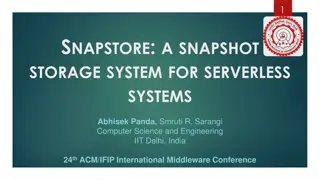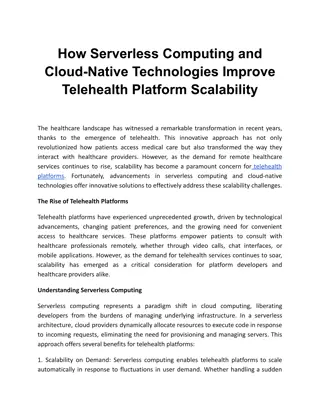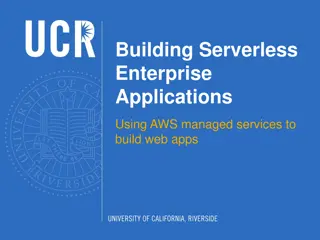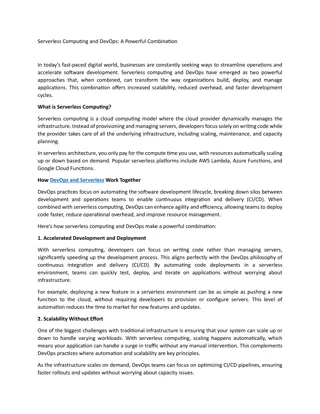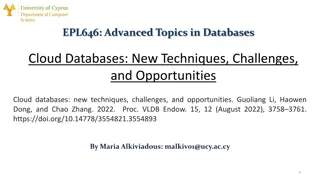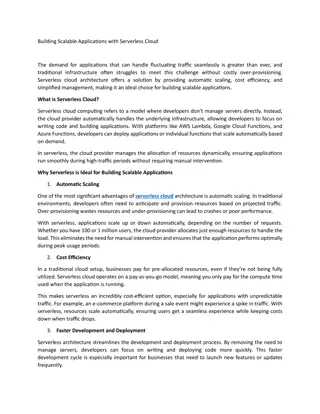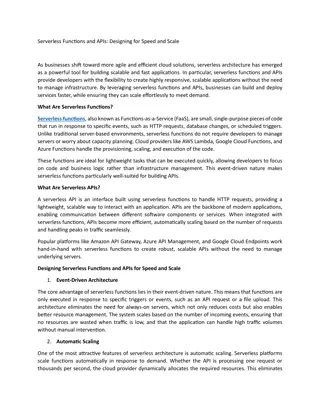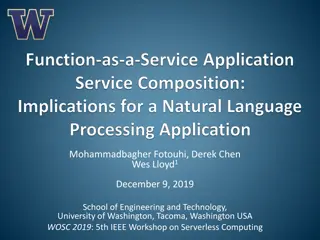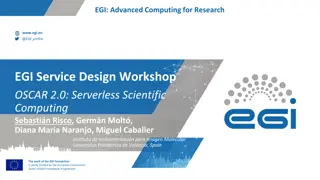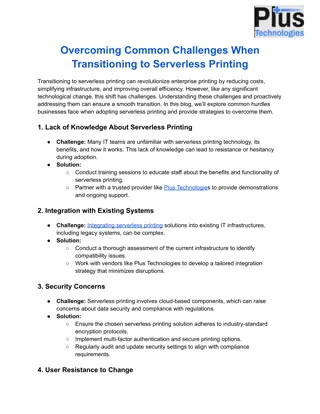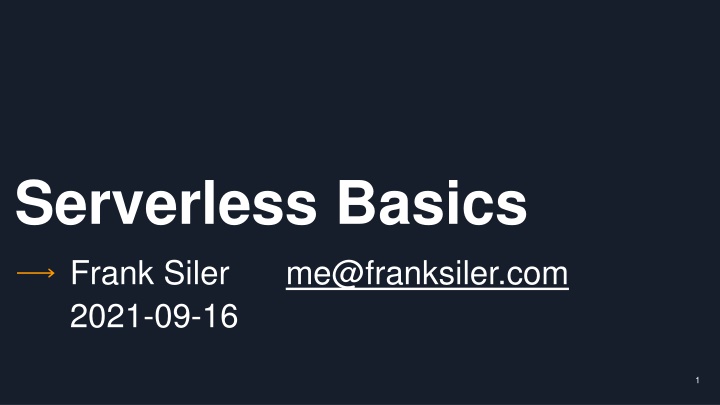
Serverless Architecture: Principles and Advantages
Discover the principles and technologies behind serverless architecture, creating highly scalable and cost-manageable software. Learn how serverless systems offer low entry barriers, hostless environments, and distributed, event-driven capabilities that enhance performance and scalability. Explore the evolution from traditional web hosting to cloud-based serverless solutions and the advantages they offer in terms of cost efficiency and uptime. Gain insights into cloud provider options and considerations for workload suitability to make informed decisions about adopting serverless technologies.
Download Presentation

Please find below an Image/Link to download the presentation.
The content on the website is provided AS IS for your information and personal use only. It may not be sold, licensed, or shared on other websites without obtaining consent from the author. If you encounter any issues during the download, it is possible that the publisher has removed the file from their server.
You are allowed to download the files provided on this website for personal or commercial use, subject to the condition that they are used lawfully. All files are the property of their respective owners.
The content on the website is provided AS IS for your information and personal use only. It may not be sold, licensed, or shared on other websites without obtaining consent from the author.
E N D
Presentation Transcript
Serverless Basics Frank Siler 2021-09-16 me@franksiler.com 1
So what is this Serverless thing, anyway? My definition: Serverless is a set of principles and technologies to allow the construction of software which is highly scalable highly available cost-manageable decomposable geographically distributed capable of being monitored 3
How do you go about that? Thoughtworks laid out these ideas. Some of the important characteristics of serverless systems are: Low barrier to entry Hostless Stateless Elastic Distributed Event-Driven https://www.thoughtworks.com/en-us/insights/blog/traits-serverless-architecture 4
It doesnt have to be complicated.. 5 https://medium.com/serverless-transformation/what-a-typical-100-serverless-architecture-looks-like-in-aws-40f252cd0ecb
How would you do it in the old days? A simple static website: Web Server index.html DNS File on disk nginx, Apache, IIS Probably from your DNS registrar or maybe your webhost Your host computer 6
The Serverless Version Cloud DNS provider, eg Route 53 Cloud Storage Provider eg S3, GCS, Azure Storage 7
So whats the big deal? You didn t change much! Exactly. Except that instead of running on one computer, we are now running on a vast distributed network. For many applications, this will cost you less and have higher uptime than the old model. BUT An aside. Cloud is not ideal for everything. It has significant advantages for workloads that are: Bursty or unpredictable Experimental Geographically distributed You must do your own math and understand your own application to make an intelligent decision. Don t be breathless about any given technology. 8
Quick Commentary on the Big Three GCP: most developer friendly Upside: Super cool databases: BQ, Spanner, BigTable Downside: losing money, not platform company / deprecation policy Azure: obvious choice if you re a Microsoft shop, particularly for MSSQL Upside: great integration for Windows stuff but also OSS friendly, privacy Downside: cost AWS: suggest choosing only if they have a specialty service you need Upside: lots of specialty services (eg, Satellite Downlink) Downside: janky. Poor documentation. A friend of a friend was the sole responsible person for EC2 for 12 hours a day. 9
So what technologies do we use? Technologies to connect Technologies to remember Technologies to process and understand Technologies to diagnose and manage 10
Technologies to connect - HTTP gateway - CDN - Subnet - VPN - Firewall - Site-to-site connection - Message queues - Notification system 11
Technologies to remember - Object storage / artifact repository - Caching databases: memcache, redis - Distributed databases: MongoDB, Cassandra, CouchDB - Then the big boys- proprietary, globally distributed: - AWS: DynamoDB, RedShift - GCP: Firestore, BigTable, Cloud Spanner, BigQuery - Azure: CosmosDB - And then possibly the most interesting: modern serverless databases with old-school APIs: - AWS: Aurora (MySQL and PostgreSQL), DocumentDB (MongoDB) - GCP: Atlas (MongoDB) - Azure: Azure SQL Database (MSSQL), Azure DB for PostgreSQL 12
Technologies to process and understand - Functions and general compute - Machine Learning - Sentiment analysis - Text and document processing - Image and video processing - Speech processing - Agents - Translation - Search 13
Technologies to diagnose and manage - Logging - Tracing - Monitoring - Profiling - User management - Source control - Deployment tools - Cost management 14
Third Party products - Auth0 login - Twilio telephony 15
Limitations of serverless - Your whole world generally belongs to someone else - Vendor lock-in - Latency, costs, tech support - The world can shift underneath you - Can be annoying to debug - Cold Starts - Limited runtime support - Per-unit costs (OpEx) tend to be higher - Local dev can be more complex than more traditional setups - Fewer tools set up for it 16 https://www.oreilly.com/library/view/what-is-serverless/9781491984178/ch04.html
Some example applications 17
Example: S3 archiver - So here s the thing: by default, you upload to the Standard storage class, which is $0.023/GB in us-east1. By contrast, Deep Glacier storage is nearly 25x cheaper - But here s the thing: you pay for operations , which include the copy that you need to change storage classes, and you also pay for 8KB of Standard storage and 32KB of Glacier for every object in Glacier. - Therefore, it never makes sense to archive objects 8KB or smaller 18
Example: auto transcode on video upload - Didn t have a chance to get this up and running, but it s the same kind of idea, except that we re kicking off an outside task - https://motorscript.com/automate-aws-elastic-transcoder-s3- files-using-lambda-functions/ 19
Questions? 21
Resources Possibly my favorite introductory talk: Sam from ACloudGuru https://youtu.be/Cd0qLRkTubk For the old-fashioned (but still valid) way: Hosting deals aggregator: lowendbox.com Hosting: ssdnodes.com https://martinfowler.com/articles/serverless.html https://www.oreilly.com/library/view/what-is- serverless/9781491984178/ Interesting blogs http://rachelbythebay.com/w/ https://boyter.org/posts/abusing-aws-to-make-a-search-engine/ 22


